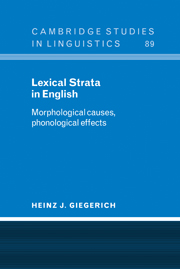Book contents
- Frontmatter
- Contents
- Acknowledgements
- 1 A requiem for Lexical Phonology?
- 2 Affix-driven stratification: the grand illusion
- 3 Principles of base-driven stratification
- 4 Derving the Strict Cyclicity Effect
- 5 Phonology and the literate speaker: orthography in Lexical Phonology
- 6 [r]-sandhi and liaison in RP
- 7 Input vowles to [r]-sandhi: RP and London English
- 8 Syllables and strata
- Notes
- References
- Subject index
- Index of words, roots and affixes
6 - [r]-sandhi and liaison in RP
Published online by Cambridge University Press: 22 September 2009
- Frontmatter
- Contents
- Acknowledgements
- 1 A requiem for Lexical Phonology?
- 2 Affix-driven stratification: the grand illusion
- 3 Principles of base-driven stratification
- 4 Derving the Strict Cyclicity Effect
- 5 Phonology and the literate speaker: orthography in Lexical Phonology
- 6 [r]-sandhi and liaison in RP
- 7 Input vowles to [r]-sandhi: RP and London English
- 8 Syllables and strata
- Notes
- References
- Subject index
- Index of words, roots and affixes
Summary
Explananda
[r]-sandhi: linking and intrusion
My main concern in this chapter and the following will be [r]-sandhi: the phenomenon of ‘linking [r]’ and ‘intrusive [r]’ in RP and its synchronic derivation within Lexical Phonology. The singular form, ‘phenomenon’, is appropriate here. While the descriptive accounts (for example Wells 1982; Giegerich 1992a; Gimson 1994) and many of the more formal analyses found in the literature (Kahn 1976; Mohanan 1984, 1985; Nespor and Vogel 1986; Broadbent 1991; McCarthy 1991, 1993; Scobbie 1992; McMahon, Foulkes and Tollfree 1994; Harris 1994; Kamińska 1995; McMahon 1996) tend to draw the well-known distinction between ‘linking [r]’ and ‘intrusive [r]’ (see the examples in (1) below), reporting that RP speakers freely use the former but often shun the latter, it is also clear from the descriptions that the avoidance of [r]-intrusion does not come naturally to those speakers: it is brought about and maintained only thanks to continuous enforcement by a strong intrusion stigma (Gimson 1994: 263f.). It may well be more natural for the RP speaker to have both linking and intrusion than it is to have the former but not the latter. The deliberateness of intrusion-avoidance alone suggests that linking and intrusion may, in purely synchronic-phonological terms, be nondistinct (and stronger arguments to this effect will be given below); but any account dealing with the phenomenon also has to address the question of how it is that at least some speakers (especially those of ‘speech-conscious adoptive RP’ Wells 1982: 284f.) succeed in implementing the intrusion stigma with remarkable reliability.
- Type
- Chapter
- Information
- Lexical Strata in EnglishMorphological Causes, Phonological Effects, pp. 167 - 197Publisher: Cambridge University PressPrint publication year: 1999

